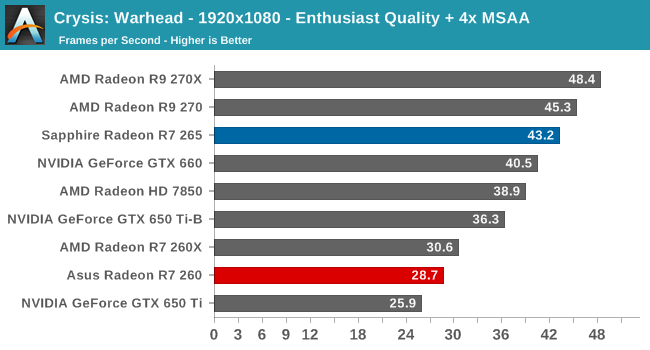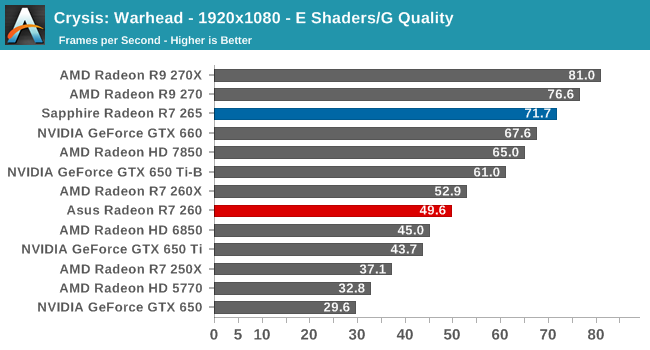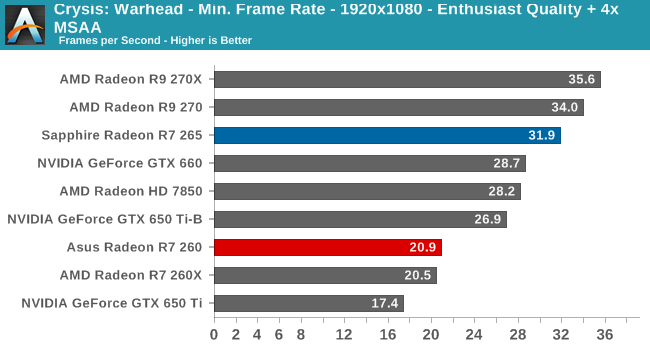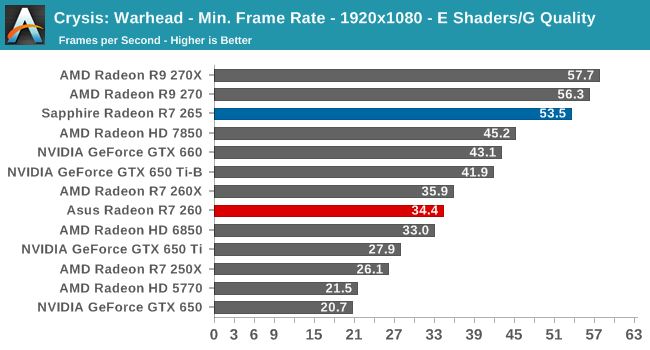The AMD Radeon R7 265 & R7 260 Review: Feat Sapphire & Asus
by Ryan Smith on February 13, 2014 8:00 AM ESTCrysis: Warhead
Up next is our legacy title for 2013/2014, Crysis: Warhead. The stand-alone expansion to 2007’s Crysis, at over 5 years old Crysis: Warhead can still beat most systems down. Crysis was intended to be future-looking as far as performance and visual quality goes, and it has clearly achieved that. We’ve only finally reached the point where single-GPU cards have come out that can hit 60fps at 1920 with 4xAA, never mind 2560 and beyond.


For Crysis: Warhead, AMD is once again in control. The R7 265 trails only the other 200 series Pitcairn cards, passing the GTX 660 by 6%. Meanwhile the R7 260 holds an even greater 14% advantage over the GTX 650 Ti.












52 Comments
View All Comments
edzieba - Thursday, February 13, 2014 - link
It's not just a tool for flagging up multi-screen/multi-GPU stutter issues. By showing the distribution of frame times, you can tell the difference between two cards that both average 50fps, but where one delivers every frame in 20 +/- 1 ms, and the other at +/- 5. The latter will deliver a much smoother output, which is not apparent from a single-number metric.Anandtech readers are a pretty smart bunch. We'd much prefer Graph Overload to too little information, particularly when other sites provide the additional information as standard.
Death666Angel - Thursday, February 13, 2014 - link
Sounds like the first (+/- 1 ms) would deliver the smoother experience than the latter (+/- 5 ms). :)edzieba - Monday, February 17, 2014 - link
Urp, that's what I /meant/ to write...Cellar Door - Thursday, February 13, 2014 - link
This rebadge game is terrible. Both parties are guilty here but the fact that these products get reviewed on regular basis just makes no sense.Here is a proper review of the of the 265 and 260: Lets confuse everyone with new nomenclature and what basically is a 7850 from close to 2 years ago. These cards are nothing but cash cows for the mainstream.
This card is being launched to draw attention to AMD just before the GTX 750 Ti comes to the market, its nothing but emptying the stocks of poor quality chips.
MrSpadge - Thursday, February 13, 2014 - link
Guess what: they wouldn't build GPUs if they wouldn't expect them to be cash cows!EnzoFX - Thursday, February 13, 2014 - link
THis has always been the case in the not-high-tier cards. Where have you been? I love these cards. What's wrong with an "update" to tried and true cards. I love these single-pcie-power cards. Besides, most games will prob still be targeting this level of power considering it's comparable to the new consoles.Death666Angel - Thursday, February 13, 2014 - link
First time I can remember there being rebadging was with the 8xxx / 9xxx series from nVidia, before that I don't remember it happening.LordOfTheBoired - Friday, February 14, 2014 - link
GeForce4 MX was a modified GeForce2. While not a straight same-component relabel, it WAS intentionally-misleading branding meant to make people think it was an upgrade from the GeForce 3 rather than a downgrade, and was very much in the spirit of the modern rebadge.That's the earliest example that springs to mind here.
rallyhard - Friday, February 14, 2014 - link
I agree that your example, the GeForce4 MX is one of the earliest, and probably one of the most misleading rebrands ever.The first video card I ever purchased was a rebrand that occurred a year earlier, though: the lowly Radeon 7000. It was the exact same card as the previous RV100-based Radeon LE, but they gave it a flashy new name when they introduced the new Radeon 7500 with the RV200 chip.
silverblue - Friday, February 14, 2014 - link
The GeForce 4 MX was probably a worse release than the 2 MX in that the latter was indeed based on the GeForce 2, but lacked the hardware transform and lighting capabilities of the GeForce 2 GTS and the earlier GeForce 256. The GeForce 2 MX 400 was the only model that had a chance of beating the 256 DDR.The Radeon 9000 was a hacked down 8500 LE, but I suppose considering the low number in the 9xxx series, there had to be a low-end part. Besides which, it did still have T&L.
I can't think of any straight rebrands from back then apart from the 7000.